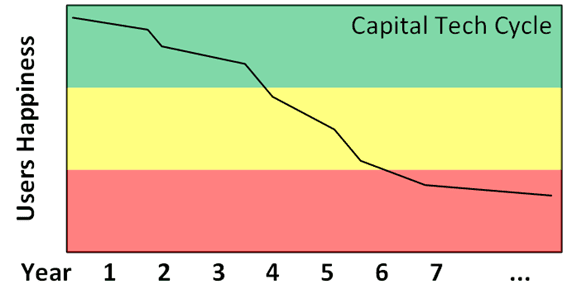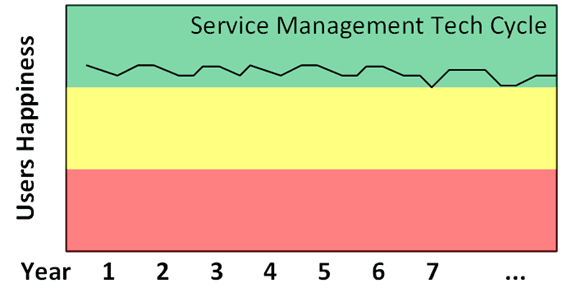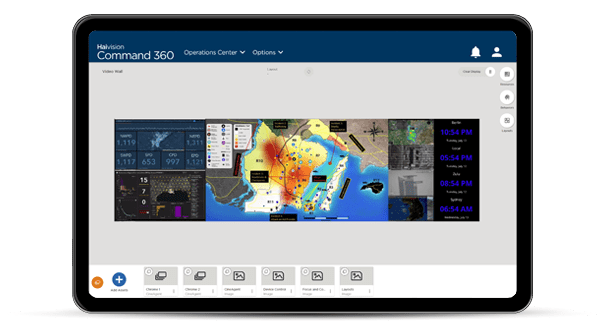Technology changes at a rapid pace. Business requirements change at a rapid pace. Rarely do these changes courteously wait to align with capital purchasing cycles. Designing an operations center to meet only today’s requirements limits the lifetime of an expensive asset. However, designing an ops center to meet all possible future technical and business requirements is prohibitively expensive, and perhaps impossible.
The IT industry has addressed the issue of changing requirements by implementing Service Delivery Management practices. These methods measure system performance over time, based on current requirements and priorities defined by organizational stakeholders. Management then gradually updates the service to meet these goals. It allows for maximum operational efficiencies over the service lifetime because the service (the functional characteristics delivered to the users) can be adjusted as required.
Service Delivery Management methods can extend the functional lifecycle of an operations center by extending the useful life of the system.
Adjusting Perspective
In today’s AV industry, the technology lifecycle usually follows a capital purchase and depreciation model. This is best expressed by “Here’s your new operations center. I’ll see you in seven years.” It means that the user is happy for three years, neutral for two years, and angry for two years. Then the cycle starts again.

Service Delivery Management introduces a practice of continually monitoring the needs of the service client (in this case the operations center users or clients) and making incremental adjustments to the delivered services in order to maintain an agreed upon level of service. Metrics are defined to meet any business goal including the cost of the service.

A common example of operations center technology that is difficult to adapt over time is a video wall processor. The inputs and outputs are both tied directly to the processor, limiting the number of simultaneous input and outputs to the frame size. These installations often include matrix switchers placed ahead of the video processor to expand the number of available inputs. Expansion is limited to the capacity set during the initial installation.
Leveraging Components Over IP
Distributing video sources over IP instead allows the discrete addition of encoders and additional displays or video processors. These devices can be added, moved, or dropped incrementally as needed without significant infrastructure upgrades. Moving media transport on to IP networks requires proper data isolation and security considerations. However, there are potential gains in operational flexibility. IP-based media transport systems offer increased resiliency, the capacity to recover quickly from or limit the impact of failures. This is generally a high priority for operations centers.
Haivision’s CineNet™ Platform offers unparalleled flexibility in configuring a visual collaboration system, like an operations center video wall. It allows an operations team to meet evolving organizational requirements while integrating into an existing IT infrastructure. CineNet is an ideal platform for service design and management of an operations center. Running on Windows 10 Enterprise LTSC 2019, CineNet can be added to the organization’s domain, be put under the Group Policy management, and leverage Active Directory services to control access and privileges. The software is built on a highly scalable and reconfigurable IP video distribution structure with the ability to share media on an isolated network.
To read more about employing service delivery methodologies to optimize your operations center investment, download the Service Delivery Management for Evolving Control Rooms white paper. Contact Haivision directly to discuss our video wall solutions or schedule a demo.
